
The Prince Albert (PA) is a penis piercing which extends from the urethra to the underside of the glans. It is one of the most common male genital piercings. The related reverse Prince Albert piercing enters through the urethra and exits through a hole pierced in the top of the glans.

A navel piercing is a type of piercing that penetrates the skin of the navel. It is most commonly located on the upper fold of skin but can also be affected underneath or around the edges of the navel. Healing usually takes around 6–12 months but varies person-to-person due to differences in physiology.

The nipple is a raised region of tissue on the surface of the breast from which, in lactating females, milk from the mammary gland leaves the body through the lactiferous ducts to nurse an infant. The milk can flow through the nipple passively, or it can be ejected by smooth muscle contractions that occur along with the ductal system. The nipple is surrounded by the areola, which is often a darker colour than the surrounding skin.

Nose piercing is the piercing of the skin or cartilage which forms any part of the nose, normally for the purpose of wearing jewelry, called a nose-jewel. Among the different varieties of nose piercings, the nostril piercing is the most common.

An earring is a piece of jewelry attached to the ear, commonly via a piercing in the earlobe or another external part of the ear, or by some other means, such as stickers or clip-ons. Earrings have been worn across multiple civilizations and historic periods, often carrying a cultural significance.
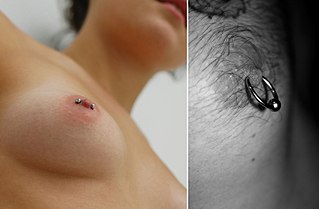
A nipple piercing is a type of body piercing, centered usually at the base of the nipple. It can be pierced at any angle but is usually done horizontally or, less often, vertically. It is also possible to place multiple piercings on top of one another.
Body piercing jewelry is jewelry manufactured specifically for use in body piercing. The jewelry involved in the art of body piercing comes in a wide variety of shapes and sizes in order to best fit the pierced site. Jewelry may be worn for fashion, cultural tradition, religious beliefs, personal symbolism, and many other reasons.
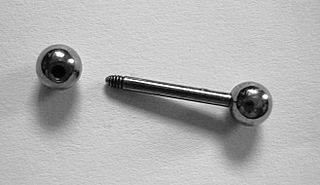
Barbell style piercing jewelry is composed of a straight bar with a bead on each end, one or both beads unscrewable for removal and/or changing of the beads. Often one of the beads is fixed, either via epoxy or welding, so that only one bead is used to install or remove the jewelry. Barbell threads are usually right-handed.
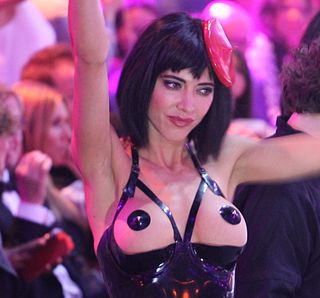
Pasties are patches that cover a person's nipples and areolae, typically self-adhesive or affixed with adhesive. They are usually worn in pairs. They originated as part of burlesque shows, allowing dancers to perform fully topless without exposing the nipples in order to provide a commercial form of bare-breasted entertainment. Pasties are also, at times, used while sunbathing, worn by strippers and showgirls, or as a form of protest during women's rights events such as Go Topless Day. In some cases this is to avoid potential prosecution under indecency laws.

An inverted nipple is a condition where the nipple, instead of pointing outward, is retracted into the breast. In some cases, the nipple will be temporarily protruded if stimulated. Both women and men can have inverted nipples.

Labia piercings are a type of female genital piercing. This piercing can be placed either through the labia minora or the labia majora. They are one of the simpler and more common genital piercings performed on vulvas, and are often pierced in symmetrical pairs. Like all genital piercings, depending on jewellery and placement, they may provide additional stimulation to one or both partners during sexual intercourse.

A nipple shield is a nipple-shaped sheath worn over the areola and nipple during breastfeeding. Modern nipple shields are made of soft, thin, flexible silicone and have holes at the end of the nipple section to allow the breast milk to pass through.
Mastopexy is the plastic surgery mammoplasty procedure for raising sagging breasts upon the chest of the woman, by changing and modifying the size, contour, and elevation of the breasts. In a breast-lift surgery to re-establish an aesthetically proportionate bust for the woman, the critical corrective consideration is the tissue viability of the nipple-areola complex (NAC), to ensure the functional sensitivity of the breasts for lactation and breast-feeding.

Genital jewellery, also known as sex jewellery and adult jewellery, is jewellery which is designed specifically for wear on or to accentuate the genitals. In a wider sense also nipple rings and some butt-plugs may be called genital jewellery.

Ptosis or sagging of the female breast is a natural consequence of aging. The rate at which a woman's breasts drop and the degree of ptosis depends on many factors. The key factors influencing breast ptosis over a woman's lifetime are cigarette smoking, her number of pregnancies, higher body mass index, larger bra cup size, and significant weight change. Post-menopausal women or people with collagen deficiencies may experience increased ptosis due to a loss of skin elasticity. Many women and medical professionals mistakenly believe that breastfeeding increases sagging. It is also commonly believed that the breast itself offers insufficient support and that wearing a bra prevents sagging, which has not been found to be true.
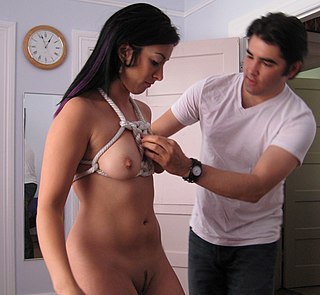
Breast torture is a BDSM activity in which sexual stimulation is provided through the intentional application of physical pain or constriction to the breasts, areolae or nipples of a submissive. It is a popular activity among the kink community. The recipient of such activities may wish to receive them as a result of masochism or they may have a desire to please a dominant who is sadistic. Those involved may also be motivated by breast fetishism. Mild breast torture such as light impact play on the breasts is also occasionally used outside of the BDSM context to provide stimulation and pleasure during conventional sex.

A plug, in the context of body modification, is a short, cylindrical piece of jewelry commonly worn in larger-gauge body piercings. Modern western plugs are also called flesh tunnels. Because of their size—which is often substantially thicker than a standard metal earring—plugs can be made out of almost any material. Acrylic glass, metal, wood, bone, stone, horn, glass, silicone or porcelain are all potential plug materials.

Body piercing, which is a form of body modification, is the practice of puncturing or cutting a part of the human body, creating an opening in which jewellery may be worn, or where an implant could be inserted. The word piercing can refer to the act or practice of body piercing, or to an opening in the body created by this act or practice. It can also, by metonymy, refer to the resulting decoration, or to the decorative jewelry used. Piercing implants alter the body and/or skin profile and appearance. Although the history of body piercing is obscured by popular misinformation and by a lack of scholarly reference, ample evidence exists to document that it has been practiced in various forms by both sexes since ancient times throughout the world. Body piercing can be performed on people of all ages, although most minors are only permitted to have earlobe piercings.
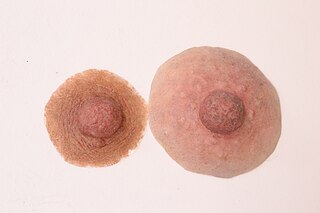
Nipple/Areola prostheses are made of silicone by breast prosthesis manufacturers and anaplastologists for breast cancer survivors who were treated for breast cancer with a mastectomy. Prostheses can be worn weeks after a mastectomy, breast reconstruction, or even nipple reconstruction. As an inexpensive and convenient alternative to surgery, patients may choose to wear them anytime during treatment. Patients who ultimately find nipple prostheses thought that they should be informed of them during the consultation prior to mastectomy.


















